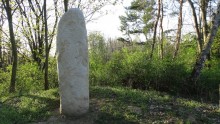|
|
|
|
SeehausenStanding Stone / Menhir
|
||||||||||||||||||
|
|
|
Images (click to view fullsize) |
|
Photographs:

 Maps / Plans / Diagrams:
Maps / Plans / Diagrams:
|
Fieldnotes |
|
|
The Menhir of Seehausen (also called "Götterstein" or "Langer Stein") is a pillar about 2.25 m high with incised motifs (head, bow, ax, sandals). Unfortunately, the original Menhir had to be replaced by a replica to protect against vandalism and brought to the State Museum of Prehistory in Halle. Take the L77 westwards towards Eggenstedt. Some 1.2 km after leaving the village there is a single house on the left, here you drive another 200 m and park on the left side. At a sharp angle follow a small dirt road to the left, after about 250m, when you reach a field on the right, the stone is on the left side. Visited April 2019 |
29th April 2019ce |
|
taken from the information board: Menhir of Seehausen »Götterstein«, »Langer Stein« Corded Ware culture (circa 2800-2200 BC) The term menhir is a borrowed from the Breton name for an erected, single elongated stone (Breton maen, English »stone«, hir, English »long«). An identification as a menhir and the temporal classification can often only be verified by an excavation. Most are unprocessed; however, some were given a human form by having a highly stylized face and other person attributes. Menhirs, according to the current state of research, did not have the character of a tombstone, in other words they did not primarily mark a grave. However, they are certainly to be put in a cultic context. The pillared Menhir of Seehausen consists of quartzitic gray sandstone. It was found around 1800 at the »digging of the earth« on prehistoric burial mounds on the hill opposite to the south and erected in 1816 as a cemetery monument at its current location. The original is heavily devastated and has more recent traces of vandalism. To prevent further damage, the stone was transferred to the State Museum of Prehistory in Halle and replaced by a copy. The 2.25 m high pillar or statue menhir of Seehausen is processed all around and decorated with engraved lines. An older drawing shows the representation of a warrior with a stylized head. Directly below the circular face is a double line interpreted as a bow. In the below engraved belt with oval lock an ax is hung. Heel parts of sandals are shown on the right side of the body. Very similar menhirs with warrior attributes and sandal prints are known from the Black Sea area and have apparently served as a model for the stone stele from Seehausen. Based on the carved motifs, the Menhir from Seehausen can be dated to the Late Neolithic Corded Ware culture (around 2800-2200 BC). |
29th April 2019ce |

